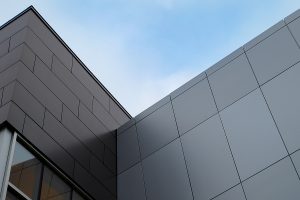
Sandwich panels are composite materials made by bonding two thin outer skins to a lightweight core. The skins can be made of a variety of materials such as aluminum, steel, fiberglass, or composite materials. The core is typically made of a lightweight material such as foam and honeycomb.
The combination of the skins and core creates a strong, lightweight and rigid panel that can be used for a wide range of applications.
Thanks to their characteristic lightness and strength qualities, composite sandwich panels enable the execution of ambitious projects, representing an essential step towards a new era of design.
The rise of sandwich panels in designing
That’s why sandwich panels are commonly used in the aerospace, automotive, construction, transport and marine industries, among others.
They offer several advantages over traditional solid panels, such as weight reduction, increased stiffness, and improved insulation properties. Additionally, sandwich panels can be customized to meet specific performance requirements by varying the materials used in their construction.
The challenges of working with sandwich panels
When working with sandwich panels, some critical points to consider are:
Material compatibility: It is essential to ensure that the materials used for the outer skins and core are compatible with each other to avoid any chemical reactions that may damage the panel.
Handling: Sandwich panels are lightweight but can be fragile, and mishandling them can lead to damage, resulting in a reduction in performance or even breakage.
Temperature sensitivity: Sandwich panels may be sensitive to high temperatures, which can cause the core material to expand, leading to delamination or warping. On the other hand, low temperatures can make the core brittle, leading to cracking or crushing.
Moisture exposure: Sandwich panels can absorb moisture, which can cause the core material to deteriorate, leading to reduced performance or structural failure.
Inspection: Regular inspections of sandwich panels are essential to detect any signs of damage or degradation and take appropriate corrective action before it leads to failure.
Fastening: The fastening method used for sandwich panels can significantly impact their structural integrity. Proper techniques must be used to avoid damaging the panel and ensure adequate load transfer between the skin and core.
Enhance Your Composite Material Projects with Specialinsert® Fastening Solutions
At Specialinsert®, we take pride in offering a wide range of high-quality fastening systems, all designed and manufactured in Italy to meet the unique needs of composite materials. Our fastening solutions are specifically engineered to provide superior performance, reliability, and durability, ensuring that your composite material projects are secure and long-lasting.
Our products include:
MASTER-PLATE®, a fastening system that uses adhesives to be attached to any type of material. It can also be used with screws, rolling or co-moulding. The base plate can be fitted with a threaded or unthreaded attachment and can take various shapes. It is produced in both galvanised steel and AISI 316L stainless steel.
DEFORM-NUT® TC/SC/1, a knurled threaded tubular rivet nut- Extra short type for sandwich panels. This is a stainless steel system consisting of a threaded tubular rivet coupled with a threaded, adjustable blind grub screw placed inside the rivet.
DEFORM-NUT®, a metal threaded tubular rivet nut with a deformable expansion chamber at the top, to anchor to the material. It can be installed on parts where there is no possibility of access to the inside (e.g. tubes, sheet metal, section bars, box-structures, etc.) and is easy and quick to install, versatile, aesthetic and with high mechanical sealing characteristics. The product is also available in AISI 316 stainless steel and in titanium (DEFORM-TI® series).
FAST-CON®, a patented stainless steel snap-on metal fastening system that allows panelling and cladding to be easily connected. A concealed, corrosion- and flame-resistant and long-lasting solution.
RUBBER-FIX®, the revolutionary anti-vibration, snap-on fastening system that allows panelling and cladding subject to strong vibrations to be quickly connected by means of simple pressure. The system consists of two elements: the male is a steel pin fixed by screwing or gluing; the female is made of rubber and is fastened by pressure.




